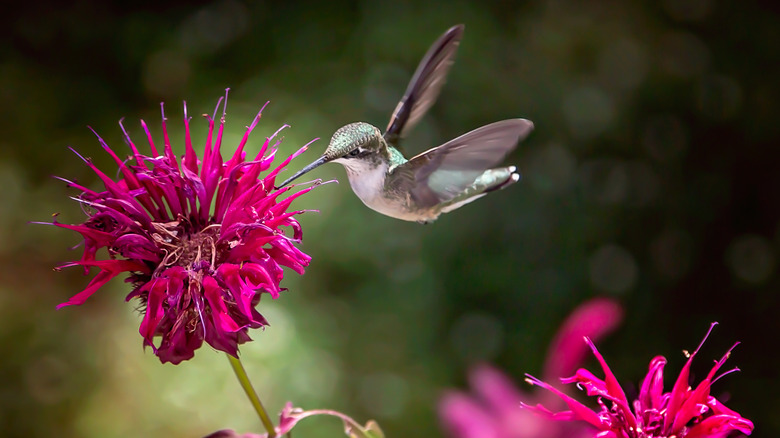What You Can Do In Winter To Attract More Hummingbirds With Bee Balm In Spring
Bee balm, bergamot, Oswego tea, and horsemint are all common names for Monarda, a flowering herb in the mint family. With a red, fuchsia, or purple spiky flower head that looks a bit like a jester's hat, these projections are actually a crown of curved tubes. A combo of tubular blossoms and bright colors in the red family make bee balm an alluring treat for hummingbirds. According to House Digest's Gardening Editor and in-house Master Gardener, Tiffany Selvey, you can save money and attract hummingbirds to your yard by starting bee balm from seed. It's not particularly hard to grow, but you can improve your chances of germination by planting this winter.
Bee balm is one of the many perennials that can benefit from seed stratification. Although it's not a requirement for the seeds to sprout, a period of cold can boost seeds' sprouting time. Get a head start on your bee balm by starting seeds in containers kept outdoors or simply scattering them in your flower beds. It's best to do this several months before your last frost date, but weathering them even for a few weeks in chilly temps can help.
One thing to keep in mind is that perennials can take up to three years to produce flowers. Selvey explains, "The first year you plant seeds, perennials develop their root system. The second year, the stems and leaves really develop to start soring up energy. Finally, the third year, it really grows and blooms." You can benefit from bee balm blooms this year by adding a few established plants now while your seeds grow and mature.
Out in the cold
If you're too busy to mess with winter sowing, you can try snow seeding. Also called frost seeding or dormant seeding, this process entails broadcasting your seeds on the soil or even a layer of snow. "The seeds will sink into the snow or settle into the soil, which breaks down the tough outer shell in time for it to germinate," states Selvey. Bee balm grows best in full sun, so pick a well-draining spot that will get at least six hours of sunlight per day during the growing season.
Snow seeding can expose seeds to hungry animals and brisk winds, but you can eliminate those factors by winter sowing. To do this, gather up a few plastic containers, like translucent juice bottles or milk jugs and cut them in half horizontally. Poke holes in the tops and bottoms of your containers for drainage.
Fill the containers with potting mix, scatter seeds on top of the soil, and press them lightly into the surface. Spray the soil with water, and close the containers; using duct tape to hold the container halves together. Label the containers, and place them outside in an area where they'll get lots of sun and natural moisture. If you live in a dry area, you'll need to water the containers to keep soil and seeds from drying out. Once your area starts warming up for the spring, look for sprouts. Once the temperature increases, you can remove the container tops during the day and replace them at night. Transplant the seedlings to larger pots or to your garden when they are big enough to fill the container.
